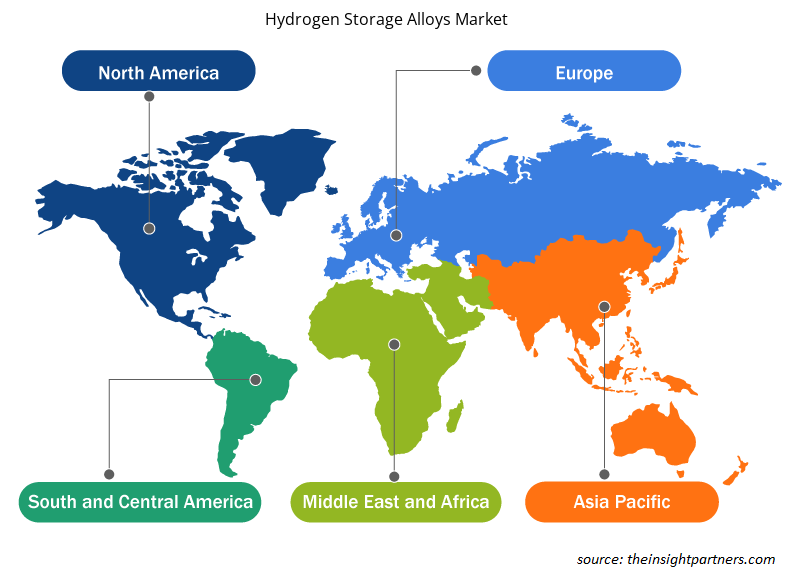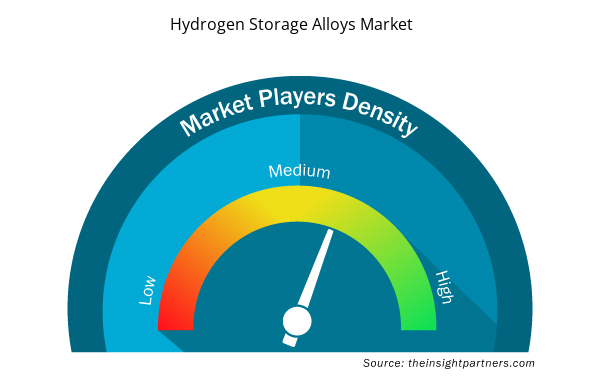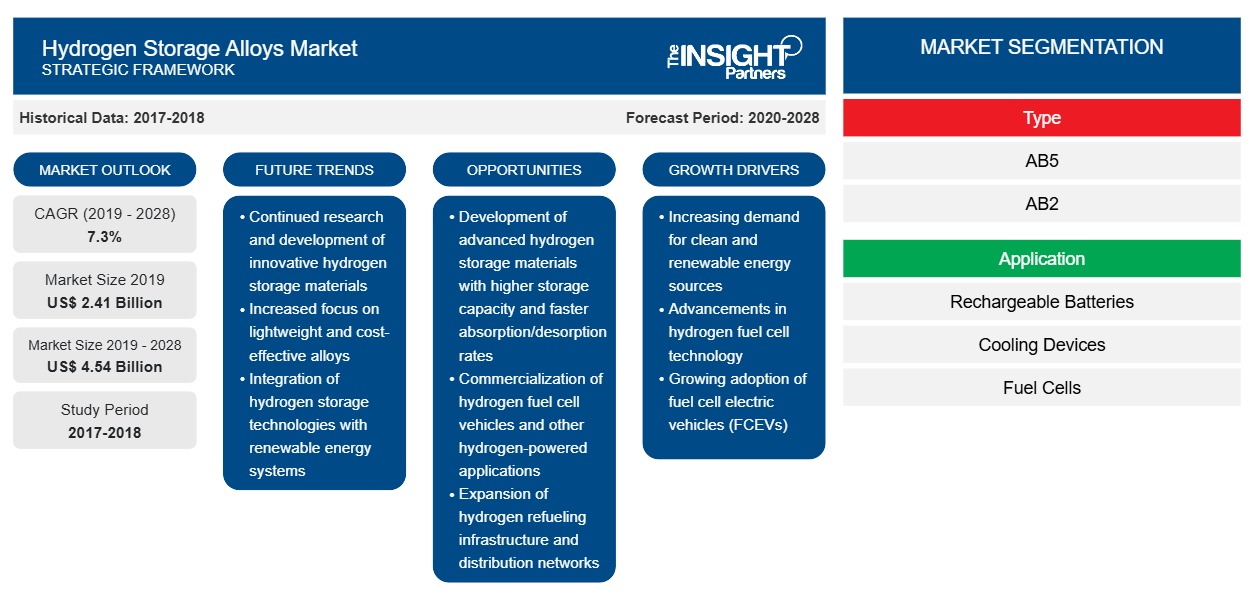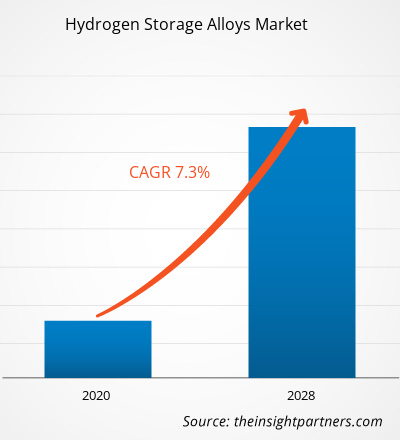水素貯蔵合金市場は2019年に24億688万米ドルと評価され、2028年までに45億3553万米ドルに達すると予測されており、 2020年から2028年にかけて7.3%のCAGRで成長すると予想されています。
水素吸蔵合金は、AB5、AB2、AB、A2B などのいくつかのタイプの金属間化合物に分類されます。グループ A の元素は基本的に La、Ti、Zr、Mg などで構成され、B は Ni、Co、Fe、Mn などで構成され、その水素化物はそれぞれ熱力学的に安定および不安定です。これらのうち、AB5 と AB2 は最も有望で広く使用されている水素吸蔵合金です。これらの合金は、気相または電気化学的に大量の水素を可逆的に吸収および放出する独自の能力を備えた金属材料です。
2019年、北米は水素貯蔵合金の最大の市場でした。自動車産業における環境に優しい技術の需要の高まりは飛躍的に増加しており、これはモビリティ分野の新規プレーヤーである水素に新たな可能性をもたらします。それが北米地域の水素貯蔵合金市場を推進しています。北米の水素貯蔵合金市場の主要な成長要因の1つは、顧客のアプリケーションを満たすようにカスタム設計されていることです。さらに、JMC、Inc.、FuelCell Energy、Inc.など米国の多くの企業が、将来および既存のアプリケーション向けの水素貯蔵容器の設計と製造に積極的に関与しており、予測期間中の水素貯蔵合金の需要をさらに押し上げます。この地域での電子製品の需要の増加により、水素化学物質の魅力的な市場が生まれました。したがって、電子産業における技術の進歩と成長により、予測期間中の水素貯蔵合金の需要が押し上げられると予測されています。
進行中のパンデミックは、水素生成産業の状況を劇的に変え、水素貯蔵合金市場の成長に悪影響を及ぼしています。COVID-19の発生により、国境や国境が突然閉鎖されたため、運用効率が歪められ、バリューチェーンが混乱し、収益の損失と損害が発生しています。たとえば、Energy Industry Reviewが発表したレポートによると、パンデミックに伴う経済危機により、クリーンな水素エネルギーの採用と商業化が大幅に遅れる可能性があります。これは、エネルギー移行におけるミッシングリンクとして水素セクターがスムーズに機能する能力にも影響を与える可能性があります。混乱したバリューチェーンは原材料の供給に悪影響を及ぼし、それが今度は水素貯蔵合金市場の成長に影響を与えています。しかし、経済が事業の復活を計画しているため、水素貯蔵合金の需要は世界的に高まると予想されています。ジャストインタイム生産への焦点は、市場の成長を妨げるもう1つの懸念要因です。パンデミック後の時代に水素ベースの経済への注目が高まる中、水素貯蔵合金の需要は、用途基盤の拡大により飛躍的に増加すると予想されます。さらに、分散型発電や先進技術の導入とともに政府が講じる積極的な対策も、市場の成長を後押しすると予想されるもう1つの要因です。
要件に合わせてレポートをカスタマイズする
このレポートの一部、国レベルの分析、Excelデータパックなど、あらゆるレポートを無料でカスタマイズできます。また、スタートアップや大学向けのお得なオファーや割引もご利用いただけます。
- このレポートの主要な市場動向を入手してください。この無料サンプルには、市場動向から見積もりや予測に至るまでのデータ分析が含まれます。
市場分析
水素生成・貯蔵システムの急増
水素は重要な要素の 1 つと考えられており、気体状態で豊富に存在します。重要なエネルギー源としての水素の潜在的な使用は、近年、さまざまな用途で大きな注目を集めています。燃料電池および水素エネルギー協会によると、再生可能エネルギーをさまざまなディスパッチ可能なエネルギー源で置き換えることへの注目が高まっているため、水素の生成と貯蔵の需要が大幅に高まっています。協会によると、水素エネルギー貯蔵は、再生可能エネルギーによって生成された余剰エネルギーを貯蔵する技術であり、ピストン エンジンやガスタービンの燃料など、さまざまな目的に使用できます。国際エネルギー機関によると、電気分解メカニズムの助けを借りて生成された水素は、経済的な燃料の選択肢として大きな将来性を秘めており、風力源から生成されたこのような水素は、2030 年までに比較的コスト効率が高く、天然ガスよりも安価になると予測されています。したがって、大規模なエネルギー貯蔵用の地下洞窟や小規模貯蔵用のスチール コンテナーでの水素の生成と貯蔵の需要が高まると予想されます。水素エネルギー貯蔵の需要拡大とともに、再生可能エネルギー源としての水素への注目が高まるにつれ、世界市場で水素貯蔵合金の需要が刺激されると予想されます。それに応じて、水素貯蔵合金、高圧水素ガス貯蔵、液体水素貯蔵、水素補給ステーションでのその他の技術など、いくつかの技術が水素を貯蔵するために大幅に使用されてきました。
タイプインサイト
タイプに基づいて、水素貯蔵合金市場はAB5とAB2に分割されています。AB5セグメントは、2019年に最高の市場シェアで水素貯蔵合金市場をリードしました。AB5タイプの水素貯蔵合金Mm(Ni、Mn、Co、Al)5は、現在広く使用されている合金シリーズの1つです。組成MmNi3.55Mn0.4Al0.3Co0.75の合金は、コスト、サイクル寿命、貯蔵容量に関して実用的なバッテリーの最低要件を満たすことが示されています。AB5合金は、通常希土類金属(La、Ce、Nd、Pr、Y、またはミッシュメタルとして知られるそれらの混合物)である水素化物形成金属Aと、水素化物を形成しない元素であるニッケルを組み合わせています。後者は、材料の安定性を向上させたり、水素での充電放電に必要な平衡水素圧と温度を調整したりするために、Co、Sn、Alなどの他の金属をドープすることができます。これにより、予測期間中に市場の成長が促進されると予想されます。
アプリケーションインサイト
用途に基づいて、水素貯蔵合金市場は、充電式バッテリー、冷却装置、燃料電池、その他に分類されます。充電式バッテリーは、新エネルギー車両にとって最も重要な技術の1つです。その中でも、ニッケル水素(Ni-MH)バッテリーは、高出力機能、過充電または放電に対する耐性、環境適合性、安全性のため、HEVで早くから広く使用されています。バッテリーの主な利点は、NiCadバッテリー用に開発されたアルカリ電解液と正極ニッケル水酸化物カソードの両方を保持することです。これにより、体積エネルギーが大幅に増加します(Ni-Cadの120 Wh.L-1からNi-MHの240 Wh.L-1へ)。さらに、環境に有毒なカドミウムの代替品であることも大きな利点です。最後に、Ni-MHバッテリーの充放電電気化学反応には水が関与しないため、Ni-Cadバッテリーとは異なり、サイクル全体にわたってセル内の水分含有量が一定に保たれます。さらに、この二元化合物は、その水素化物 (LaNi5H6) が通常の圧力および温度条件下では自然に分解するため、開放型電池の陽極としては適していません。
主要な市場プレーヤーには、JMC、Merck KGaA、Ajax Tocco Magnethermic Corporation、Baotou Santoku Battery Materials Co., Ltd.、Santoku Corporation、American Elements、AMG Titanium Alloys & Coatings LLC、Jiangmen Kanhoo Industry Co., Ltd、Xiamen Tungsten Co., Ltdが含まれます。水素貯蔵合金市場の主要プレーヤーは、合併や買収、製品の発売などの戦略に焦点を当て、地理的プレゼンスと消費者ベースを世界的に拡大しています。
レポートの注目点
- 世界の水素貯蔵合金市場における進歩的な業界動向は、プレーヤーが効果的な長期戦略を策定するのに役立ちます。
- 先進国市場と発展途上国市場で採用されているビジネス成長戦略
- 2017年から2027年までの世界の水素貯蔵合金市場の定量分析
- さまざまな業界における水素貯蔵合金の需要の推定
- 市場の成長を予測するために業界で活動するバイヤーとサプライヤーの有効性を示すPEST分析
- 競争的な市場シナリオと水素貯蔵合金の需要を理解するための最近の動向
- 水素貯蔵合金市場の成長を牽引および抑制する要因と相まって、市場の動向と見通し
- 世界の水素貯蔵合金市場の成長に関する商業的利益を支える戦略を理解することによる意思決定プロセス
- 市場のさまざまなノードにおける水素貯蔵合金の市場規模
- 世界の水素貯蔵合金市場の詳細な概要とセグメンテーション、および業界におけるその動向。
- 有望な成長機会があるさまざまな地域の水素貯蔵合金市場規模
水素貯蔵合金市場の地域別分析
予測期間を通じて水素貯蔵合金市場に影響を与える地域的な傾向と要因は、Insight Partners のアナリストによって徹底的に説明されています。このセクションでは、北米、ヨーロッパ、アジア太平洋、中東、アフリカ、南米、中米にわたる水素貯蔵合金市場のセグメントと地理についても説明します。

- 水素貯蔵合金市場の地域別データを入手
水素貯蔵合金市場レポートの範囲
| レポート属性 | 詳細 |
|---|---|
| 2019年の市場規模 | 24億1000万米ドル |
| 2028年までの市場規模 | 45億4千万米ドル |
| 世界のCAGR(2019年 - 2028年) | 7.3% |
| 履歴データ | 2017-2018 |
| 予測期間 | 2020-2028 |
| 対象セグメント | タイプ別
|
| 対象地域と国 | 北米
|
| 市場リーダーと主要企業プロフィール |
|
水素貯蔵合金市場のプレーヤー密度:ビジネスダイナミクスへの影響を理解する
水素貯蔵合金市場は、消費者の嗜好の変化、技術の進歩、製品の利点に対する認識の高まりなどの要因により、エンドユーザーの需要が高まり、急速に成長しています。需要が高まるにつれて、企業は提供を拡大し、消費者のニーズを満たすために革新し、新たなトレンドを活用し、市場の成長をさらに促進しています。
市場プレーヤー密度とは、特定の市場または業界内で活動している企業または会社の分布を指します。これは、特定の市場スペースに、その市場規模または総市場価値に対してどれだけの競合相手 (市場プレーヤー) が存在するかを示します。
水素貯蔵合金市場で事業を展開している主要企業は次のとおりです。
- JMC(日本重化学工業株式会社)
- メルク
- アヤックス・トッコ・マグネサーミック・コーポレーション
- 包頭三徳電池材料株式会社
- 株式会社三徳
免責事項:上記の企業は、特定の順序でランク付けされていません。

- 水素貯蔵合金市場のトップキープレーヤーの概要を入手
世界の水素貯蔵合金市場(タイプ別)
- AB5
- AB2
世界の水素貯蔵合金市場、用途別
- 充電式電池
- 冷却装置
- 燃料電池
- その他
企業プロフィール
- JMC
- メルク
- アヤックス・トッコ・マグネサーミック・コーポレーション
- 包頭三徳電池材料株式会社
- 株式会社三徳
- アメリカの要素
- AMG チタニウム アロイ & コーティング LLC
- 江門カンホー産業株式会社
- 厦門タングステン株式会社
- 過去2年間の分析、基準年、CAGRによる予測(7年間)
- PEST分析とSWOT分析
- 市場規模価値/数量 - 世界、地域、国
- 業界と競争環境
- Excel データセット



Report Coverage
Revenue forecast, Company Analysis, Industry landscape, Growth factors, and Trends

Segment Covered
This text is related
to segments covered.

Regional Scope
North America, Europe, Asia Pacific, Middle East & Africa, South & Central America

Country Scope
This text is related
to country scope.
よくある質問
The rechargeable batteries segment held the largest share in the global hydrogen storage alloys market in 2019. Hydrogen storage alloys such as AB2 and AB5 are widely used in rechargeable batteries such as NiMH batteries, lithium-ion based batteries and metal-air batteries. Though the market for these batteries is currently at a mature stage and its technology offers limited scope for innovation they are vital component of the power source in consumer appliances and industrial applications. For instance, NiMH batteries installed in several gadgets such as toys, cameras electronics, other electronics and hybrid vehicles, and electric cars. Similarly, lithium-ion battery finds its major application in laptops, PDAs, cell phones, and iPods. Enhanced chemical and mechanical stability of hydrogen storage alloys make them a popular choice for these batteries. Thus, the rapid growth of the electrical and electronic sector acts as a major driver for the growth of the rechargeable batteries which eventually supports the growth of hydrogen storage alloys
The major players operating in the global hydrogen storage alloys market are JMC, Merck KGaA, Ajax Tocco Magnethermic Corporation, Baotou Santoku Battery Materials Co., Ltd., Santoku Corporation, American Elements, Hunan Corun New Energy Co., Ltd, Jiangmen Kanhoo Industry Co., Ltd, Xiamen Tungsten Co., Ltd. among many others.
In 2019, APAC contributed to the largest share in the global hydrogen storage alloys market. The growth of the hydrogen storage alloys market in this region is primarily attributed to the development of new applications such as hydrogen powered fuel cells for transportation. Escalating demand for clean energy generation has increased use of fuel cell-based vehicles which is driving the market for hydrogen storage alloys in the region. In addition, hydrogen storage alloys find vast applications in electronics devices such as smartphones, laptops, PDAs and other consumer electronics. Surge in demand for consumer electronics in developing countries such as India and China is expected to support the growth of hydrogen storage alloys market. Hydrogen storage technology has its wide application in chemicals, metal working, general industrial, transportation, stationary power, portable power, and transportation. Hydrogen storage alloys are used in fuel cell, cooling devices, rechargeable batteries and other components such as sensors, activators, purification, heat pumps. They are also used in devices used for isotope separation, thermal storage, and refrigeration. Thus, the growing demand of hydrogen storage alloys for non-electro chemical applications is projected to boost the demand for hydrogen storage alloys over the forecast period. Increasing focus on research & development (R&D) for the development of hydrogen storage technology and increasing adoption of technological advancements and growth in automotive and electronics industry in the APAC region offer lucrative business opportunities for hydrogen storage alloys.
Trends and growth analysis reports related to Chemicals and Materials : READ MORE..
The List of companies - Global Hydrogen Storage Alloys Market
- JMC (Japan Metals & Chemicals Co., Ltd.)
- Merck KGaA
- Ajax Tocco Magnethermic Corporation
- Baotou Santoku Battery Materials Co. Ltd.
- Santoku Corporation
- American Elements
- AMG Titanium Alloys & Coatings LLC
- Jiangmen Kanhoo Industry Co. Ltd
- Xiamen Tungsten Co. Ltd
The Insight Partners performs research in 4 major stages: Data Collection & Secondary Research, Primary Research, Data Analysis and Data Triangulation & Final Review.
- Data Collection and Secondary Research:
As a market research and consulting firm operating from a decade, we have published and advised several client across the globe. First step for any study will start with an assessment of currently available data and insights from existing reports. Further, historical and current market information is collected from Investor Presentations, Annual Reports, SEC Filings, etc., and other information related to company’s performance and market positioning are gathered from Paid Databases (Factiva, Hoovers, and Reuters) and various other publications available in public domain.
Several associations trade associates, technical forums, institutes, societies and organization are accessed to gain technical as well as market related insights through their publications such as research papers, blogs and press releases related to the studies are referred to get cues about the market. Further, white papers, journals, magazines, and other news articles published in last 3 years are scrutinized and analyzed to understand the current market trends.
- Primary Research:
The primarily interview analysis comprise of data obtained from industry participants interview and answers to survey questions gathered by in-house primary team.
For primary research, interviews are conducted with industry experts/CEOs/Marketing Managers/VPs/Subject Matter Experts from both demand and supply side to get a 360-degree view of the market. The primary team conducts several interviews based on the complexity of the markets to understand the various market trends and dynamics which makes research more credible and precise.
A typical research interview fulfils the following functions:
- Provides first-hand information on the market size, market trends, growth trends, competitive landscape, and outlook
- Validates and strengthens in-house secondary research findings
- Develops the analysis team’s expertise and market understanding
Primary research involves email interactions and telephone interviews for each market, category, segment, and sub-segment across geographies. The participants who typically take part in such a process include, but are not limited to:
- Industry participants: VPs, business development managers, market intelligence managers and national sales managers
- Outside experts: Valuation experts, research analysts and key opinion leaders specializing in the electronics and semiconductor industry.
Below is the breakup of our primary respondents by company, designation, and region:

Once we receive the confirmation from primary research sources or primary respondents, we finalize the base year market estimation and forecast the data as per the macroeconomic and microeconomic factors assessed during data collection.
- Data Analysis:
Once data is validated through both secondary as well as primary respondents, we finalize the market estimations by hypothesis formulation and factor analysis at regional and country level.
- Macro-Economic Factor Analysis:
We analyse macroeconomic indicators such the gross domestic product (GDP), increase in the demand for goods and services across industries, technological advancement, regional economic growth, governmental policies, the influence of COVID-19, PEST analysis, and other aspects. This analysis aids in setting benchmarks for various nations/regions and approximating market splits. Additionally, the general trend of the aforementioned components aid in determining the market's development possibilities.
- Country Level Data:
Various factors that are especially aligned to the country are taken into account to determine the market size for a certain area and country, including the presence of vendors, such as headquarters and offices, the country's GDP, demand patterns, and industry growth. To comprehend the market dynamics for the nation, a number of growth variables, inhibitors, application areas, and current market trends are researched. The aforementioned elements aid in determining the country's overall market's growth potential.
- Company Profile:
The “Table of Contents” is formulated by listing and analyzing more than 25 - 30 companies operating in the market ecosystem across geographies. However, we profile only 10 companies as a standard practice in our syndicate reports. These 10 companies comprise leading, emerging, and regional players. Nonetheless, our analysis is not restricted to the 10 listed companies, we also analyze other companies present in the market to develop a holistic view and understand the prevailing trends. The “Company Profiles” section in the report covers key facts, business description, products & services, financial information, SWOT analysis, and key developments. The financial information presented is extracted from the annual reports and official documents of the publicly listed companies. Upon collecting the information for the sections of respective companies, we verify them via various primary sources and then compile the data in respective company profiles. The company level information helps us in deriving the base number as well as in forecasting the market size.
- Developing Base Number:
Aggregation of sales statistics (2020-2022) and macro-economic factor, and other secondary and primary research insights are utilized to arrive at base number and related market shares for 2022. The data gaps are identified in this step and relevant market data is analyzed, collected from paid primary interviews or databases. On finalizing the base year market size, forecasts are developed on the basis of macro-economic, industry and market growth factors and company level analysis.
- Data Triangulation and Final Review:
The market findings and base year market size calculations are validated from supply as well as demand side. Demand side validations are based on macro-economic factor analysis and benchmarks for respective regions and countries. In case of supply side validations, revenues of major companies are estimated (in case not available) based on industry benchmark, approximate number of employees, product portfolio, and primary interviews revenues are gathered. Further revenue from target product/service segment is assessed to avoid overshooting of market statistics. In case of heavy deviations between supply and demand side values, all thes steps are repeated to achieve synchronization.
We follow an iterative model, wherein we share our research findings with Subject Matter Experts (SME’s) and Key Opinion Leaders (KOLs) until consensus view of the market is not formulated – this model negates any drastic deviation in the opinions of experts. Only validated and universally acceptable research findings are quoted in our reports.
We have important check points that we use to validate our research findings – which we call – data triangulation, where we validate the information, we generate from secondary sources with primary interviews and then we re-validate with our internal data bases and Subject matter experts. This comprehensive model enables us to deliver high quality, reliable data in shortest possible time.


 このレポートの無料サンプルを入手する
このレポートの無料サンプルを入手する